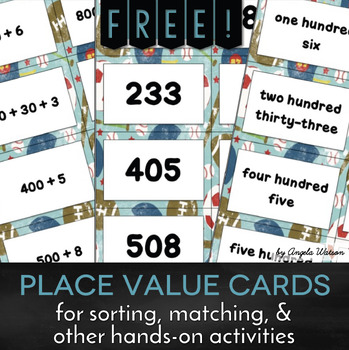FREE Place Value Cards for sorting, matching, and other base ten activities
- PDF
Description
These free place value cards can be used to help students practice using standard form/base ten numerals, expanded form, and word names/number names. You can use the cards as a sorting or matching activity for the whole class or in math centers and workstations. There are 2,3,4,5, and 6 digit numbers included as well as decimals to the thousandths, so you can print the cards you need for a wide range of student needs.
The cards are designed to be used with the following products:
1st Grade Number & Operations in Base Ten: 14 place value partner games for CCSS
2nd Grade Number & Operations in Base Ten: 14 place value partner games for CCSS
3rd Grade Number & Operations in Base Ten: 12 place value partner games for CCSS
4th Grade Number and Operations in Base Ten: 14 place value partner games for CCSS
5th Grade Number and Operations in Base Ten: 15 place value partner games for CCSS
The games listed above are $1 each and are sold as a bundle for the domain so you get everything you need to teach all the CCSS standards for first, second, third, fourth, or fifth grade number and operations in base ten, including multiple games for the major standards so students can explore the concepts in different ways.
With your game purchase, you'll receive:
* 20 pages of info and forms that contain everything you need to get started with math partner games. There are blank partner game lists, tips (with photos!) for how to create/ store/ organize/ distribute/ collect the games, and lots of ideas for how the games can be used for skill-based mini lessons and math journal reflections.
* 10-15 pages of game instructions (depending on the grade level): there’s one page for each game, featuring the materials needed, directions for game play, a Challenge activity, Math Talk questions/prompts, the CCSS alignment, and student-friendly “I Can” statements.
* 35+ pages of sports-and-stars-themed game boards and mats, game cards, spinners, and other colorful and fun materials for game play. Most of the materials are open-ended and can be used in lots of different ways so you have fewer items to print and create. The only additional items you may need to provide (depending on the grade level) are page protector sheets, Vis-à-vis or dry erase markers, paperclips to make spinners, and some sort of 2D shape manipulatives (like tangrams or pattern blocks).
This item was added on 9.15.13.
Be sure to check out my website where there are hundreds of pages of classroom management resources that make teaching more effective, efficient, and enjoyable! You'll find photos, activities, printable forms/posters, and more.
Enjoy!
Angela
If you like this product, please consider rating it! I would love your help in spreading the word about my resources.





